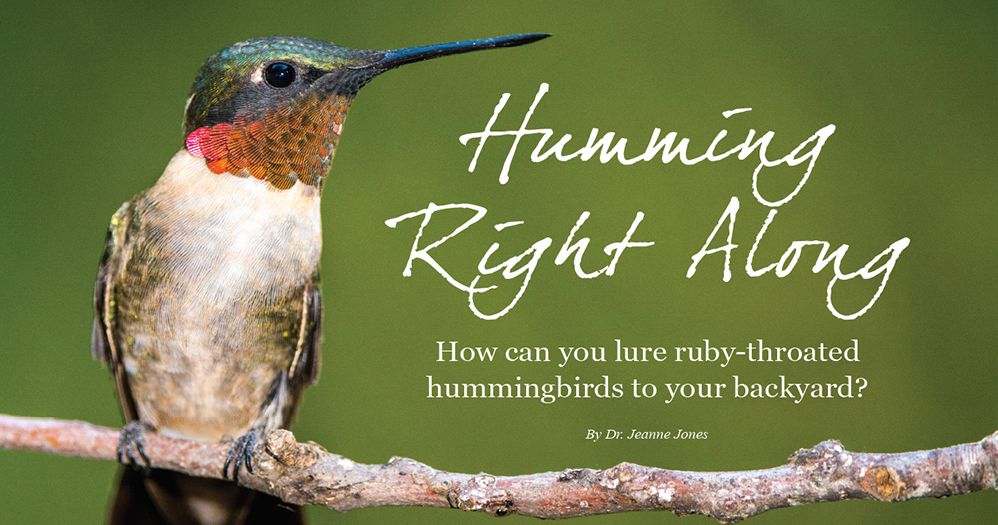Humming Right Along
7/11/2019 9:33:50 AM
By Dr. Jeanne Jones

They are territorial, aggressive, and seem to speak with a salty tongue to any who dare invade their feed-ing area. But ruby-throated hummingbirds also are among the most popular feeder birds in Mississippi because of their acrobatic behavior.
Ruby-throated hummingbirds are the most widespread hummingbird species in North America. They are migratory and usually are found in Mississippi during the breeding season, roughly from March through October. They fly thousands of miles south—often non-stop—across the Gulf of Mexico to Central America, where they spend the winter.
The staple of this bird’s diet is nectar. They spend the majority of their day searching for and feeding on flowers or feeders and actively defending their nectar sources. A hummingbird can locate and feed from more than 1,000 flowers in a single day. Ruby-throated hummingbirds’ arrival in Mississippi’s woodlands usually can be gauged with the flowering of red buck-eye, coral honeysuckle, and crossvine.
These flowers provide high-calorie nectar and attract protein-rich insects. In-sects can also be captured in flight, from spider webs, and tree sap wells. These invertebrates provide essential dietary protein for body growth, tissue repair, and breeding activities.
Therefore, to attract these birds to the yard, patio, or balcony, start with a nectar feeder. Nectar solution can be made by dissolving one part sugar into four parts of boiling water. Allow the solution to cool before putting it outside for the birds. Un-used nectar can be stored in the refrigerator. One thing is critical: do not use any red color in the sugar-water mix. Unfortunately, the red dye in some hummingbird food is harmful to the birds. The red color on the feeder is usually sufficient to lure in the hummingbirds. For information on feeding hummingbirds with nectar feeders and preparing sugar-water solutions, visit www.hummingbirdsociety.org.
To create a garden to nurture humming-birds, include both horticultural and native plants. A diversity of native food plants in an area can provide nectar and insect availability through the growing season as early spring blooming plants give way to summer and fall blooming plant species. Some plants exhibit special design features that attract hummingbirds. For example, hummingbirds are especially attracted to tubular or trumpet-shaped flowers of red, rose, orange, and lavender colors. Vine and shrub species that sport these flower types include crossvine, trumpet creeper, coral honeysuckle, wild azalea, and red buckeye. Other native plants that attract hummingbirds include wild mints, such as bergamot and wild sage, blazing star, mal-lows, lobelias, and beardtongue.
More information on these plants also can be found at hummingbirdsociety.org. An abundance of food and, over time, good nesting habitat can attract increasing numbers.
By managing land to benefit humming-birds and encouraging native plants used by hummingbirds, landowners can enhance habitat for many wildlife species. Most native hummingbird food plants produce foods for other wildlife by pro-viding cover or food sources from nectar, pollen, seed, fruits, or forage. For example, flowering plants used by humming-birds provide pollen and nectar sources for hundreds of insect species, many of which are important pollinators for fruit trees, garden plants, and agricultural crops.
Most hummingbird nectar plants produce seeds or fruits at maturation, and these foods are eaten by songbirds, quail, doves, turkeys, and small mammals. Vines, such as coral honeysuckle, crossvine, and trumpet creeper, also provide forage and browse for white-tailed deer and rabbits. Vine communities of these species in mid-story and upper tree canopies can provide important nesting and escape cover for gray squirrels and more than 30 non-gamebird species.
If you do not have space for woody vines and shrubs, wildflowers can be sufficient. Choose many different plants that will have staggered bloom times throughout the season. Although horticultural plant species are utilized by hummingbirds, native plant species are best for the birds and the environment. Native species require no fertilizers, are adapted to Mississippi’s weather conditions, and rarely are bothered with pests, which reduces the need to use chemical insecticides that are harmful to hummingbirds. Many native species can also be pruned after flowering to encourage more blooms.
While food is important for hummingbirds, other habitat needs also should be taken into consideration. Hummingbirds prefer misters, drippers, and shallow basins for water sources. When they are not feeding, hummingbirds need sheltered perches; this can be shrubs and trees with layered branches, or other manmade structures. Also, if you are fortunate and a hummingbird chooses to nest in your yard, spider webs are important for the birds to build their nests.
By creating and maintaining an abundance of native flowering plants for hummingbirds, we as property owners and managers can enjoy the beauty of native flowering plants that provide good habitat for ruby-throated hummingbirds and many other native wildlife species and pollinating insects.
Preferred plant species for hummingbird habitats
Native Vines
Cow-itch (Campsis radicans)
Coral honeysuckle (Lonicera sempervirens) Cross-vine (Bignonia capreolata) Leatherflower (Clematis reticulata)
Native Shrubs
Red buckeye (Aesculus pavia)
Sweet azalea (Rhododendron canescens) Flame azalea (Rhododendron austrinum) Sticky azalea (Rhododendron viscosum) Texas Star (Hibiscus coccineus)
Swamp rose mallow (Hibiscus moscheutos) Halberd-leaf mallow (Hibiscus laevis)
Native Wildflowers
Bee-balm (Monarda fistulosa) Cardinal-flower (Lobelia cardinalis) Jewelweed (Impatiens capensis) Red columbine (Aquilegia canadensis) Turk’s-cap lily (Lilium superbum) Indian pink (Spigelia marilandica) Obedient plant (Physostegia virginica) Virginia iris (Iris virginica)
Copper iris (Iris fulva)
Blazing star (Liatris spicata) Beardtongue (Penstemon digitalis)
Recommended Horticultural Shrubs
Lantana (Lantana camara)
Butterfly-bush (Buddleja davidii)
Recommended Horticultural Wildflowers
Salvia (Salvia spp.)
Scarlet bee-balm (Monard didyma)
Petunia (Petunia spp.)
Zinnia (Zinnia spp.)
Foxglove (Digitalis purpurea)
Dr. Jeanne Jones is Professor Emeritus of the Department of Wildlife, Fisheries, and Aquaculture at Mississippi State University.



